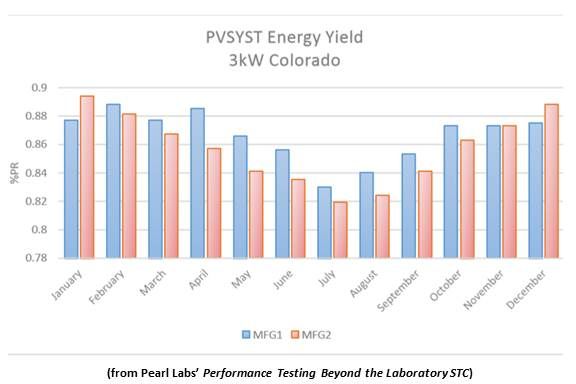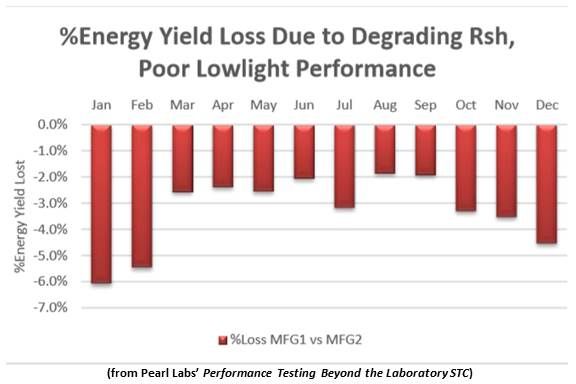A close look at two prominent thin-film photovoltaic brands by Pearl Laboratories turned up a very important finding -- when modules were tested beyond standard-test conditions.
“Both thin-film modules’ manufacturers have many megawatts installed worldwide and are commercially viable producers,” said Michelle Propst, co-founder and President of Pearl Labs. Identified only as MFG1 and MFG2 for testing purposes, the modules “have the exact same UL, TUV, IEC certifications, passed all the same safety tests and have almost identical data sheets.”
Propst and fellow Pearl Labs co-founder Anders Olsson followed NREL’s test-to-fail methodology for module testing in which procedures stop when there is more than 10 percent degradation. The protocol included damp heat, dark bake and indoor light soak testing at standard test conditions (STC) of 25 degrees centigrade, 1,000 watts per meter squared of irradiance, and an air mass of 1.5.
The lab test results for both were similar. Both passed the 1,000 hours of dark bake easily, and both performed at above 98 percent of time zero values after 1,000 hours. MFG2 reached 10 percent degradation after 2,000 hours, while MFG1 did not degrade to 10 percent until around 3,000 hours.
“Using the indoor standard test methods, the two modules more or less matched,” Propst said, confirming the data sheet and PVSyst PAN file information.
While the indoor testing went on at Pearl Labs' state-of-the-art facility in Fort Collins, Colorado (purchased at auction in the Abound Solar bankruptcy proceedings), a 3-kilowatt array was set up at Pearl Labs’ 150-kilowatt outdoor test facility in Loveland, Colorado.
Each array was set up at a 26-degree fixed tilt. SMA inverters were used.

“Outside was a very different story,” Propst said. For the first two weeks, the performance ratings of the two modules continued to match. But after that, "one of the manufacturers' modules started to degrade significantly -- but only on low light days.”
That actually confirmed the lab findings, because the lab tests were done in STC “one sun” full light, Propst said.
“But at lower than one sun, there was up to a 20 percent difference in energy yield at the end of the 45-day test period,” Propst said, “though they continued to perform essentially the same in full light.”
The conclusion from the research, Propst said, is “if you only evaluate performance in standard test conditions, which is the solar module testing industry practice, you are going to miss a significant part of energy yield performance.”
The energy yield loss can be caused by anything that causes accelerated shunt resistance (Rsh) degradation. Examples of such defects are a leaky diode, a faulty scribe or pinholes in the film stack.
Such losses are always detected first in low light because even a degraded module harvests enough of the abundance of light in a full sun to perform up to its specifications. “Eventually, the degradation will show up in full light,” Propst explained. But it is only when there is a lower volume of light that early degradation becomes evident.
“Most of the industry is aware that we need to do a better job of testing and screening,” Propst said.
Propst said. “In this case, the manufacturer would never have seen this, because the defect doesn’t exist until it is exposed to a certain temperature and irradiance.”
Module failures can be prevented by this kind of testing, Propst added. Many causes of shunt resistance degradation are the result of failed materials. In this experiment, it was linked back to a form factor issue that was caused by a choice of materials aimed at cost savings.
“Manufacturers can make these kinds of changes,” Propst said.




